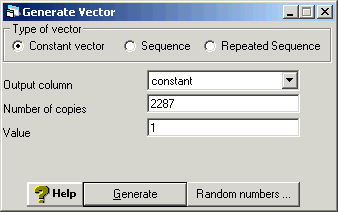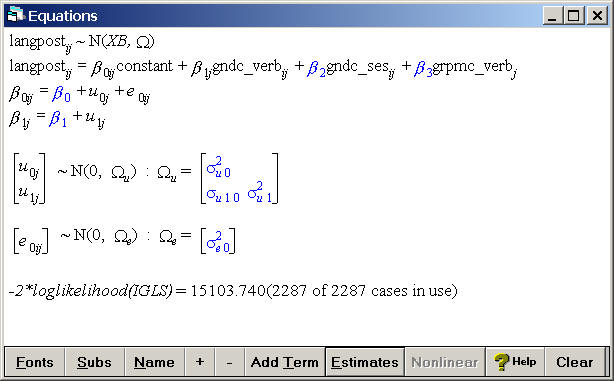Note that unless otherwise noted, we used IGLS estimation.
In this chapter we will be using the following centered variables: GndC_verb is iq_verb centered around the grand mean; GrpM_verb contains the group means of iq_verb; GrpMC_verb contains the group means of GndC_verb; GndC_ses is ses centered around the grand mean.
Furthermore, we will be creating the following centered variables: iq_tilde which is equal to gndc_verb – grpmc_verb.
From chapter 4 and 5: creating the variables constant, GndC_verb, GrpMC_verb and gndc_ses.
Creating the constant variable.
Data Manipulation Names
This opens up a window listing all the variables in the dataset with the
number of non-missing observations, missing observation, max and min for
each variable. We just need to find out the total number of observations
in the dataset but this is a nice window to have open to keep an eye on
which variables have been corrected and do they look reasonable.
Generate Vector
For the output column choose an unused variable and rename it cons by
using ctrl+n which brings up a rename window. Then enter the total
number of observations in the data set for number of copies, in this
case n=2287. Finally, enter 1 for the value since this will be a constant
variable equal to 1.
Click generate in order to execute the command
Calculating the grand mean for iq_verb and then creating the variable gndc_verb which is centered around the grand mean.
Basic Statistics Averages and Correlations Choose iq_verb and click on calculate.
Calculate Choose an unused variable and rename it gndc_verb by using ctrl+n Enter "gndc_verb" = "iq_verb" - 11.834 and click on calculate.
Creating the variable grpmc_verb which contains the group means of gndc_verb.
Data Manipulation
Multilevel Data Manipulation
in the input column choose gndc_verb, in the output column choose an unused variable and use ctrl+N
to rename it grpmc_verb then this will be the output variable
Click Add to action list which will make the input and output choices appear in the action list
on the right hand side
Click on Execute
Calculating the grand mean for ses and then creating the variable gndc_ses which is centered around the grand mean.
Basic Statistics Averages and Correlations Choose ses and click on calculate.
Calculate Choose an unused variable and rename it gndc_ses by using ctrl+n Enter "gndc_ses" = "ses" - 27.812 and click on calculate.
Creating iq_tilda which is equal to gndc_verb – grpmc_verb.
Calculate Choose an unused variable and rename it iq_tilda by using ctrl+n Enter "iq_tilda" = "gndc_verb" - "grpmc_verb" and click on calculate.
Table 6.1, model 1, p. 71.
Random slope model including grpmc_verb and gndc_ses as a fixed effects and gndc_verb as a both a random slope and as a fixed effect.
Model
Equations
Click on Y
Choose y: langpost, N levels: 2 - ij, level2(j): schoolnr, and
level1(i): pupilnr.
Click on the x0 variable
Choose the variable constant and select both schoolnr and pupilnr.
Add Term
Click on the x1 variable
Choose gndc_verb as a fixed parameter and as a random slope with variance
at the j(schoolnr) level
Add Term
Click on the x2 variable
Choose gndc_ses as a fixed parameter
Add Term
Click on the x3 variable
Choose grpmc_verb as a a fixed parameter
Click on the Start button located below the file menu and then click on estimates at the bottom of the equations window to make the estimates appear.
Table 6.1, model 2, p. 71.
Random slope model including grpmc_verb and gndc_ses as a fixed effects and iq_tilda as a both a random slope and as a fixed effect.
Model
Equations
Click on Y
Choose y: langpost, N levels: 2 - ij, level2(j): schoolnr, and
level1(i): pupilnr.
Click on the x0 variable
Choose the variable constant and select both schoolnr and pupilnr.
Add Term
Click on the x1 variable
Choose iq_tilda as a fixed parameter and as a random slope with variance
at the j(schoolnr) level
Add Term
Click on the x2 variable
Choose gndc_ses as a fixed parameter
Add Term
Click on the x3 variable
Choose grpmc_verb as a a fixed parameter
Click on the Start button located below the file menu and then click on estimates at the bottom of the equations window to make the estimates appear.






